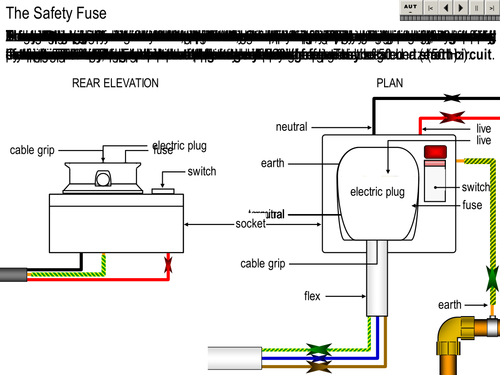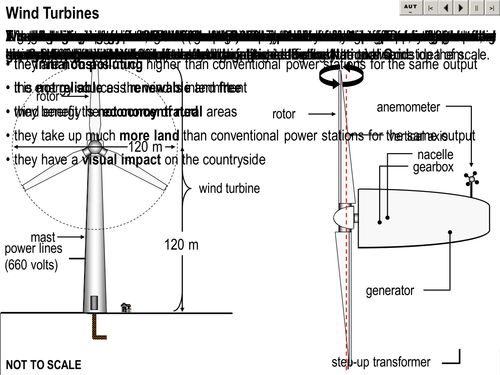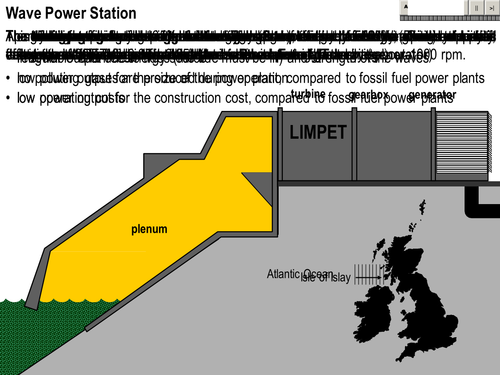
34Uploads
42k+Views
26k+Downloads
All resources

The Safety Fuse
A PPT (02+) with animated sequences demonstrating how the safety fuse requires a connection to earth in order for it melt during a fault. During animations a bar appears under the navigation buttons that wipes across until the animation has finished; it can be paused. For the buttons to work, the macro security level has to be set to medium. This is very easy and only needs to be done once; it will not compromise your computer. Select then then select. This is for ver. 2002; it might be different for later versions. COMMENTS WILL BE MUCH APPRECIATED

Wind Turbines
A PPT (02+) with animated sequences showing the major components and demonstrating how wind turbines turn the energy of the wind into electricity. During animations a bar appears under the navigation buttons that wipes across until the animation has finished; it can be paused. For the buttons to work, the macro security level has to be set to medium. This is very easy and only needs to be done once; it will not compromise your computer. Select then then select. This is for ver. 2002; it might be different for later versions. COMMENTS MUCH APPRECIATED

The Solar System
The main presentation is a PowerPoint with animated sequences showing the sizes and distances of the objects in the Solar System to scale, using two diagrams.
Support Material
Readme (instructions for whole lesson)
Learning Outcomes (PowerPoint)
Starter Activity (PowerPoint and Worksheet)
Main Activity (PowerPoint with worksheets and answer sheets)
Lesson Notes (hand-out)
Plenary Activity (PowerPoint and worksheet)
It is intended for all science teachers but particularly those who are not physics specialists. It is, primarily, aimed at 11 to 14 year old pupils but can also be used at a higher level as a precursor to a more in-depth study of this topic. Normally, the activities would fill a 45 to 60 minute lesson but could be spread over two lessons if needs be.
If you buy this resource, please print the Readme document as it contains the instructions and details of the files included.
Learning Outcomes
The learning outcomes are based on Bloom’s taxonomy of hierarchical classification: knowledge, comprehension, application, analysis, synthesis and evaluation. The lesson title and learning outcomes are:
What is meant by the term solar system?
Learning Outcomes
Knowledge
to identify the objects, and their order, in the Solar System
to state the composition of the objects in the Solar System
to identify the trends/patters in the Solar System
Differentiation
The activities have varying degrees of differentiation; please refer to the Readme document.

Nuclear Fission
The main presentation is a PowerPoint with animated sequences showing the conditions under which the nucleus of a large atom can be split by absorbing a neutron.
Support Material
Readme (instructions for whole lesson)
Learning Outcomes (PowerPoint)
Starter Activity (PowerPoint and Worksheet)
Main Activity (PowerPoint with worksheets and answer sheets)
Lesson Notes (hand-out)
Plenary Activity (PowerPoint and worksheet)
It is intended for all science teachers but particularly those who are not physics specialists. It is, primarily, aimed at 14 to 16 year old pupils but can also be used at a higher level as a precursor to a more in-depth study of this topic. Normally, the activities would fill a 45 to 60 minute lesson but could be spread over two lessons if needs be.
If you buy this resource, please print the Readme document as it contains the instructions and details of the files included.
Learning Outcomes
The learning outcomes are based on Bloom’s taxonomy of hierarchical classification: knowledge, comprehension, application, analysis, synthesis and evaluation. The lesson title and learning outcomes are:
How is it possible to split the nucleus of an atom?
Learning Outcomes
Comprehension
to recognise the forces acting in the nucleus of an atom
to explain the processes involved in nuclear fission
Differentiation
The activities have varying degrees of differentiation; please refer to the Readme document.

Nuclear Chain Reactions
The main presentation is a PowerPoint with animated sequences showing how, with a sufficient amount of fissile radioisotopes a nuclear chain reaction can take place.
Support Material
Readme (instructions for whole lesson)
Learning Outcomes (PowerPoint)
Starter Activity (PowerPoint and Worksheet)
Main Activity (PowerPoint with worksheets and answer sheets)
Lesson Notes (hand-out)
Plenary Activity (PowerPoint and worksheet)
It is intended for all science teachers but particularly those who are not physics specialists. It is, primarily, aimed at 14 to 16 year old pupils but can also be used at a higher level as a precursor to a more in-depth study of this topic. Normally, the activities would fill a 45 to 60 minute lesson but could be spread over two lessons if needs be.
If you buy this resource, please print the Readme document as it contains the instructions and details of the files included.
Learning Outcomes
The learning outcomes are based on Bloom’s taxonomy of hierarchical classification: knowledge, comprehension, application, analysis, synthesis and evaluation. The lesson title and learning outcomes are:
What is a nuclear chain reaction?
Learning Outcomes
Knowledge
to describe the different fissile properties of uranium-238 and uranium-235
to outline the conditions for a nuclear chain reaction
Differentiation
The activities have varying degrees of differentiation; please refer to the Readme document.

Ionization
The main presentation is a PowerPoint with animated sequences showing how how radiation can lead to the ionization of atoms.
Support Material
Readme (instructions for whole lesson)
Learning Outcomes (PowerPoint)
Starter Activity (PowerPoint and Worksheet)
Main Activity (PowerPoint with worksheets and answer sheets)
Lesson Notes (hand-out)
Plenary Activity (PowerPoint and worksheet)
It is intended for all science teachers but particularly those who are not physics specialists. It is, primarily, aimed at 14 to 16 year old pupils but can also be used at a higher level as a precursor to a more in-depth study of this topic. Normally, the activities would fill a 45 to 60 minute lesson.
If you buy this resource, please print the Readme document as it contains the instructions and details of the files included.
Learning Outcomes
The learning outcomes are based on Bloom’s taxonomy of hierarchical classification: knowledge, comprehension, application, analysis, synthesis and evaluation. The lesson title and learning outcomes are:
How can radiation change the properties of an atom?
Learning Outcomes
Knowledge
to state the different types of ionizing radiation and their relative ionizing strengths
to state the dangers of ionizing radiation
Comprehension
to explain the process of physical ionization
Differentiation
The activities have varying degrees of differentiation; please refer to the Readme document.

Night and Day
The main presentation is a PowerPoint with animated sequences showing how the rotation of the Earth results in night and day.
Support Material
Readme (instructions for whole lesson)
Learning Outcomes (PowerPoint)
Starter Activity (PowerPoint and Worksheet)
Main Activity (PowerPoint with worksheets and answer sheets)
Lesson Notes (hand-out)
Plenary Activity (PowerPoint and worksheet)
It is intended for all science teachers but particularly those who are not physics specialists. It is, primarily, aimed at 11 to 14 year old pupils but can also be used with younger pupils as a precursor to a more in-depth study of this topic. Normally, the activities would fill a 45 to 60 minute lesson.
If you buy this resource, please print the Readme document as it contains the instructions and details of the files included.
Learning Outcomes
The learning outcomes are based on Bloom’s taxonomy of hierarchical classification: knowledge, comprehension, application, analysis, synthesis and evaluation. The lesson title and learning outcomes are:
Why Do We Have Night And Day?
Learning Outcomes
Knowledge
to describe the Earth’s 24 hour cycle and how this results in day and night
to recognise the effect that the tilt of the Earth’s axis has on the northern and southern hemispheres
Analysis
to compare the relative times of day in different parts of the World.
Differentiation
The activities have varying degrees of differentiation; please refer to the Readme document.

States of Matter
The main presentation is a PowerPoint with animated sequences showing the differences between solids, liquids and gases.
Support Material
Readme (instructions for whole lesson)
Learning Outcomes (PowerPoint)
Starter Activity (PowerPoint and Worksheet)
Main Activity (PowerPoint with worksheets and answer sheets)
Lesson Notes (hand-out)
Plenary Activity (PowerPoint and worksheet)
It is intended for all science teachers but particularly those who are not physics specialists. It is, primarily, aimed at 14 to 16 year old pupils but can also be used for younger pupils as a precursor to a more in-depth study of this topic. Normally, the activities would fill a 45 to 60 minute lesson.
If you buy this resource, please print the Readme document as it contains the instructions and details of the files included.
Learning Outcomes
The learning outcomes are based on Bloom’s taxonomy of hierarchical classification: knowledge, comprehension, application, analysis, synthesis and evaluation. The lesson title and learning outcomes are:
What Is The Difference Between Solids, Liquids and Gases?
Learning Outcomes
Knowledge
to describe the arrangement and motion of particles in solids, liquids and gases.
to state the properties of solids, liquids and gases.
Differentiation
The activities have varying degrees of differentiation; please refer to the Readme document.

Relays
The main presentation is a PowerPoint with animated sequences showing the workings and purpose of electromagnetic relays.
Support Material
Readme (instructions for whole lesson)
Learning Outcomes (PowerPoint)
Starter Activity (PowerPoint and Worksheet)
Main Activity (PowerPoint with worksheets and answer sheets)
Lesson Notes (hand-out)
Plenary Activity (PowerPoint and worksheet)
It is intended for all science teachers but particularly those who are not physics specialists. It is, primarily, aimed at 14 to 16 year old pupils but can also be used for younger pupils. Normally, the activities would fill a 45 to 60 minute lesson.
If you buy this resource, please print the Readme document as it contains the instructions and details of the files included.
Learning Outcomes
The learning outcomes are based on Bloom’s taxonomy of hierarchical classification: knowledge, comprehension, application, analysis, synthesis and evaluation. The lesson title and learning outcomes are:
How can a low current be used to switch a high current?
Learning Outcomes
Knowledge
to identify the components in an electromagnetic relay
Comprehension
to explain the workings of an electromagnetic relay
Differentiation
The activities have varying degrees of differentiation; please refer to the Readme document.

Structure of the Earth
The main presentation is a PowerPoint with animated sequences showing how seismic activity reveals the layered structure of the Earth.
Support Material
Readme (instructions for whole lesson)
Learning Outcomes (PowerPoint)
Starter Activity (PowerPoint and Worksheet)
Main Activity (PowerPoint with worksheets and answer sheets)
Lesson Notes (hand-out)
Plenary Activity (PowerPoint and worksheet)
It is intended for all science teachers but particularly those who are not physics specialists. It is, primarily, aimed at 14 to 16 year old pupils but can also be used for younger pupils. Normally, the activities would fill a 45 to 60 minute lesson but could be spread over two lessons if need be.
If you buy this resource, please print the Readme document as it contains the instructions and details of the files included.
Learning Outcomes
The learning outcomes are based on Bloom’s taxonomy of hierarchical classification: knowledge, comprehension, application, analysis, synthesis and evaluation. The lesson title and learning outcomes are:
What is the Earth’s structure and how is it known?
Learning Outcomes
Knowledge
to identify and describe the layered structures within the Earth
Comprehension
to explain how the outer core’s structure is known through seismic activity
Differentiation
The activities have varying degrees of differentiation; please refer to the Readme document.

The Sun, the Earth and the Moon
The main presentation is a PowerPoint with animated sequences showingthe motions and relative sizes of the Sun, the Earth and the Moon.
Support Material
Readme (instructions for whole lesson)
Learning Outcomes (PowerPoint)
Starter Activity (PowerPoint and Worksheet)
Main Activity (PowerPoint with worksheets and answer sheets)
Lesson Notes (hand-out)
Plenary Activity (PowerPoint and worksheet)
It is intended for all science teachers but particularly those who are not physics specialists. It is, primarily, aimed at 11 to 14 year old pupils but can also be used at a higher level as a precursor to a more in-depth study of this topic. Normally, the activities would fill a 45 to 60 minute lesson.
If you buy this resource, please print the Readme document as it contains the instructions and details of the files included.
Learning Outcomes
The learning outcomes are based on Bloom’s taxonomy of hierarchical classification: knowledge, comprehension, application, analysis, synthesis and evaluation. The lesson title and learning outcomes are:
What are the motions and relative sizes of the Sun, the Earth and the Moon?
Learning Outcomes
Knowledge
to describe the main features of the Sun, the Earth and the Moon
to describe the movement of the Sun, the Earth and the Moon
Differentiation
The activities have varying degrees of differentiation; please refer to the Readme document.

Electromagnetic Induction
The main presentation is a PowerPoint with animated sequences showing how a voltage is induced across a coil of wire as a magnetic field cuts through it.
Support Material
Readme (instructions for whole lesson)
Learning Outcomes (PowerPoint)
Starter Activity (PowerPoint and Worksheet)
Main Activity (PowerPoint with worksheets and answer sheets)
Lesson Notes (hand-out)
Plenary Activity (PowerPoint and worksheet)
It is intended for all science teachers but particularly those who are not physics specialists. It is, primarily, aimed at 14 to 16 year old pupils but can also be used at a higher level as a precursor to a more in-depth study of this topic. Normally, the activities would fill a 45 to 60 minute lesson but could be spread over two lessons if needs be.
If you buy this resource, please print the Readme document as it contains the instructions and details of the files included.
Learning Outcomes
The learning outcomes are based on Bloom’s taxonomy of hierarchical classification: knowledge, comprehension, application, analysis, synthesis and evaluation. The lesson title and learning outcomes are:
How Can electricity Be Generated Using Magnetism?
Learning Outcomes
Knowledge
to describe the effect a magnetic field has on a conductor
to identify the factors that determine the size of the induced voltage in a conductor
Differentiation
The activities have varying degrees of differentiation; please refer to the Readme document.

Ohm's Law and Resistance
The main presentation is a PowerPoint with animated sequences showing the relationship between voltage and current across a fixed resistance.
Support Material
Readme (instructions for whole lesson)
Learning Outcomes (PowerPoint)
Starter Activity (PowerPoint and Worksheet)
Main Activity (PowerPoint with worksheets and answer sheets)
Lesson Notes (hand-out)
Plenary Activity (PowerPoint and worksheet)
It is intended for all science teachers but particularly those who are not physics specialists. It is, primarily, aimed at 14 to 16 year old pupils but can also be used at a higher level as a precursor to a more in-depth study of this topic. Normally, the activities would fill a 45 to 60 minute lesson but could be spread over two lessons if needs be.
If you buy this resource, please print the Readme document as it contains the instructions and details of the files included.
Learning Outcomes
The learning outcomes are based on Bloom’s taxonomy of hierarchical classification: knowledge, comprehension, application, analysis, synthesis and evaluation. The lesson title and learning outcomes are:
What Is The Relationship Between Current, Voltage And Resistance?
Learning Outcomes
Knowledge
to identify the components needed to investigate Ohm’s Law and to draw the circuit diagram
to describe the effect that voltage has on current
to describe the effect that heat has on resistance of conductors and semi-conductors
Analysis
to use Ohm’s Law to calculate voltage, current and resistance
Differentiation
The activities have varying degrees of differentiation; please refer to the Readme document.

Wave Energy
A PPT (02+) with animated sequences demonstrating how the safety fuse requires a connection to earth in order for it melt during a fault. During animations a bar appears under the navigation buttons that wipes across until the animation has finished; it can be paused. For the buttons to work, the macro security level has to be set to medium. This is very easy and only needs to be done once; it will not compromise your computer. Select then then select. This is for ver. 2002; it might be different for later versions. COMMENTS WILL BE MUCH APPRECIATED














